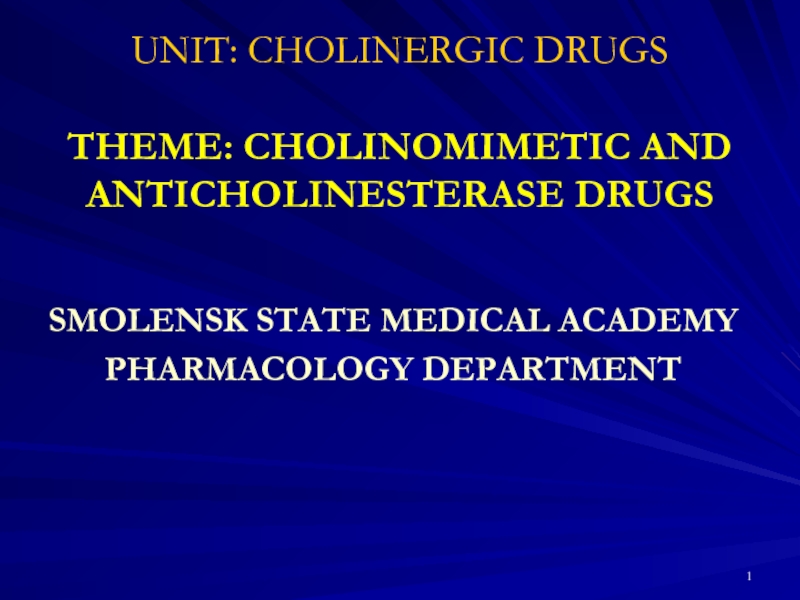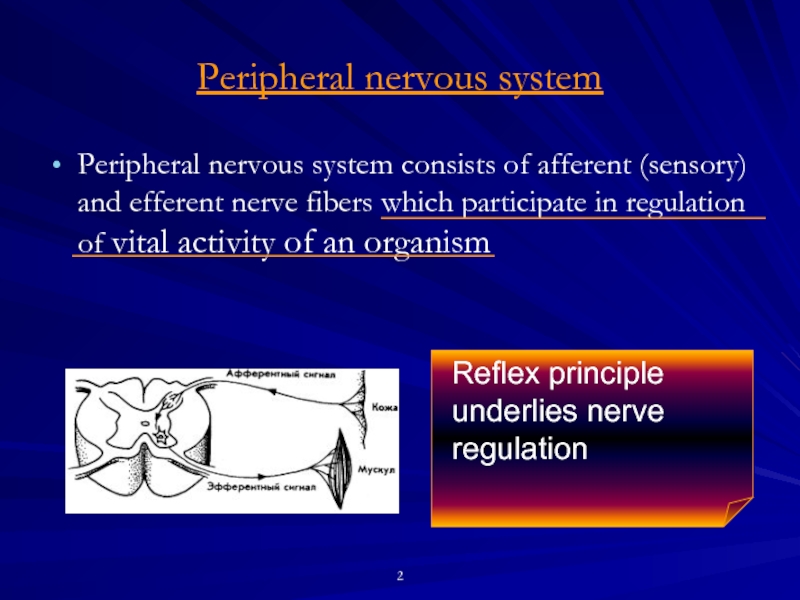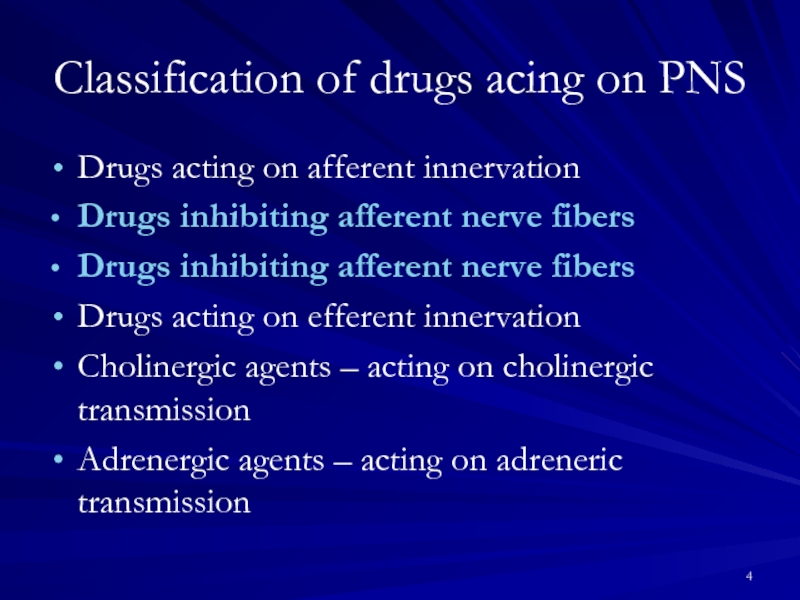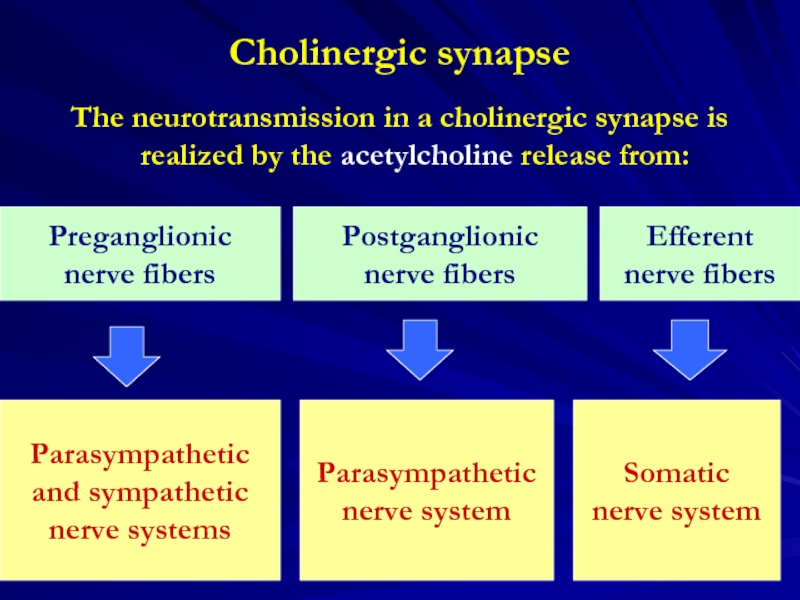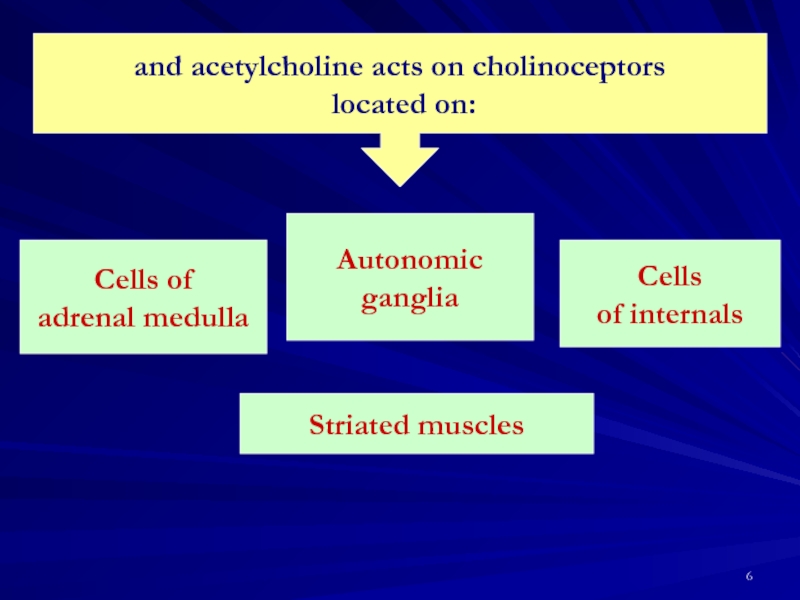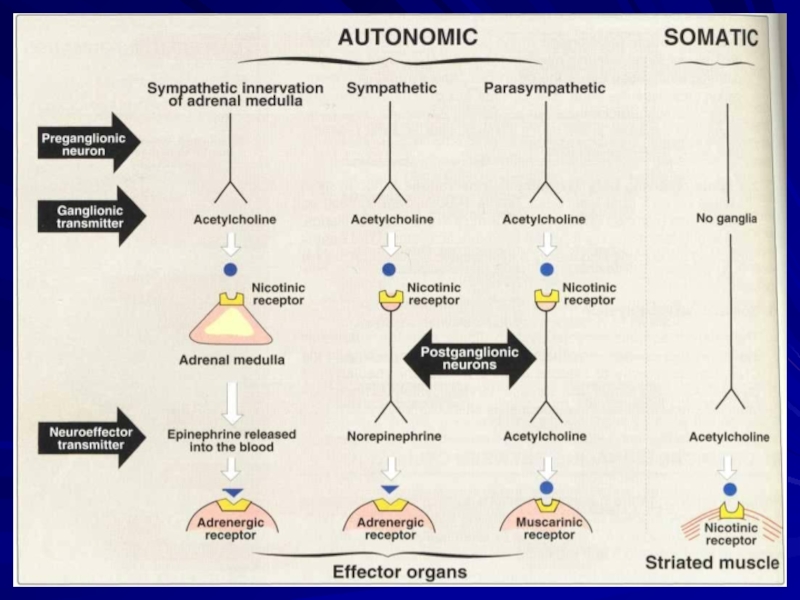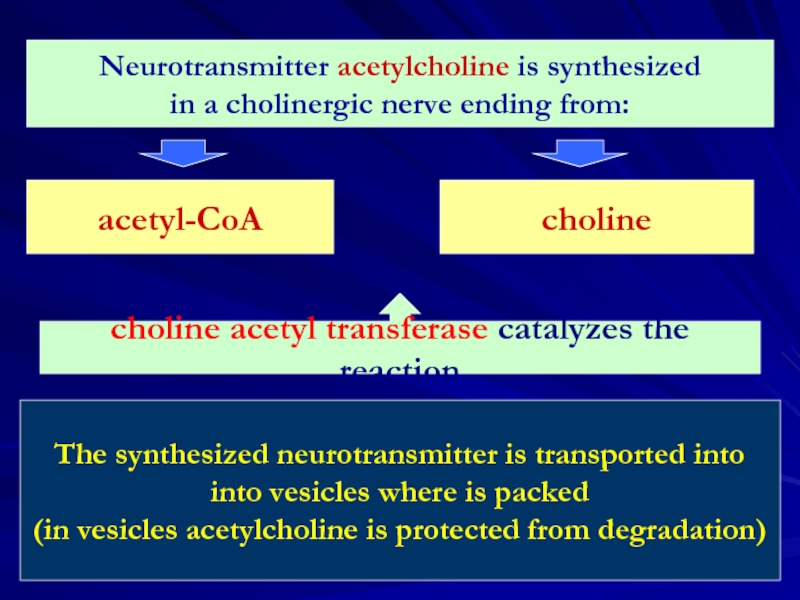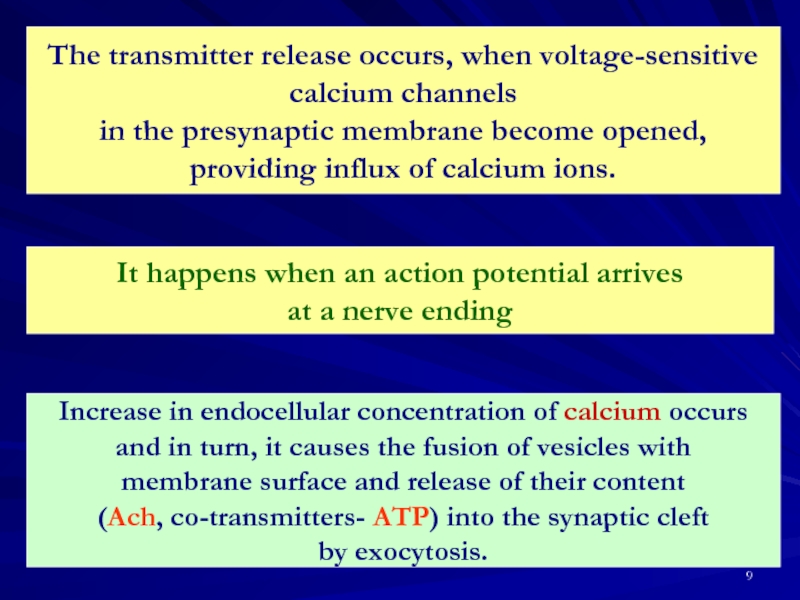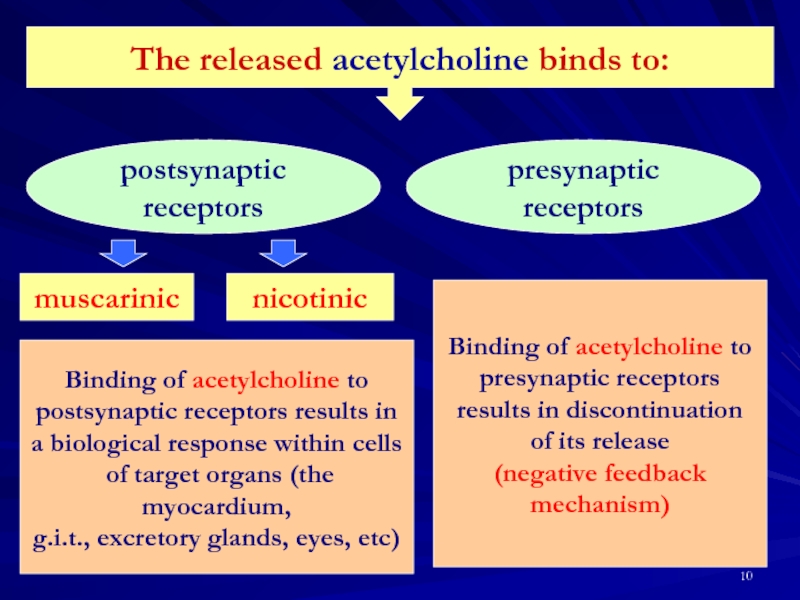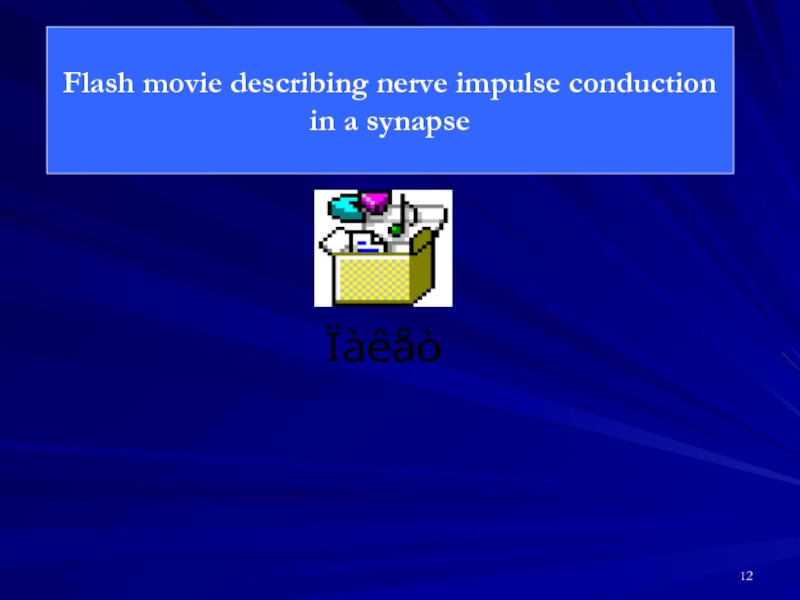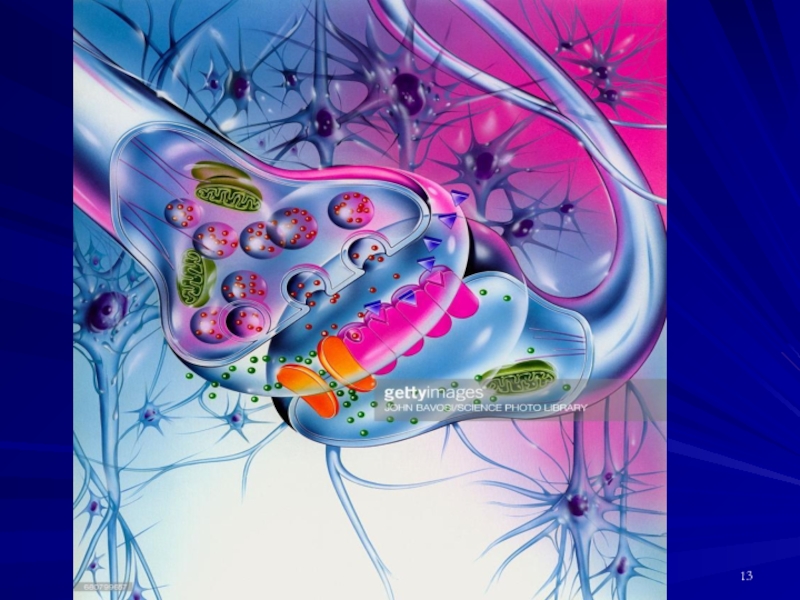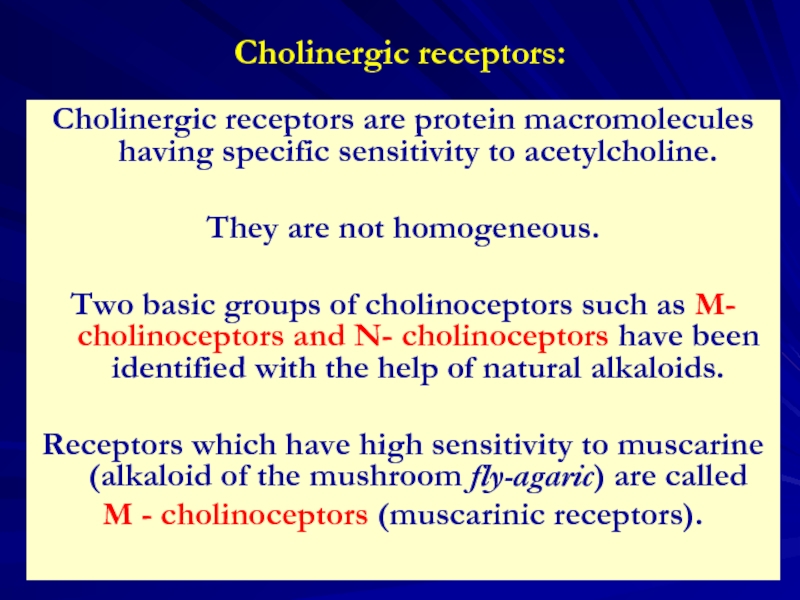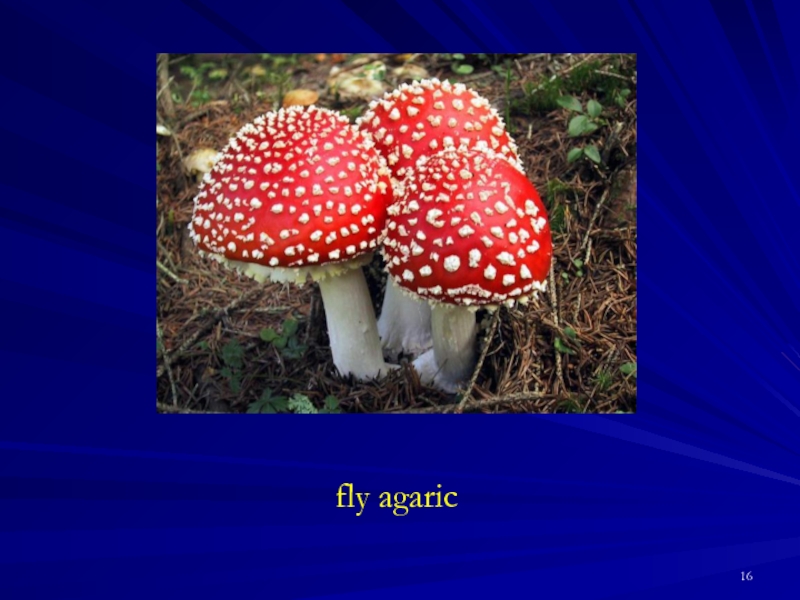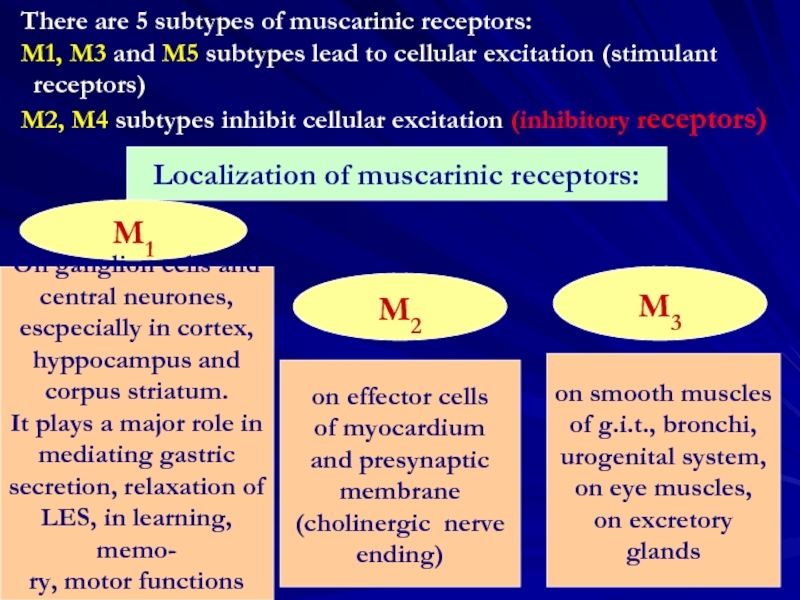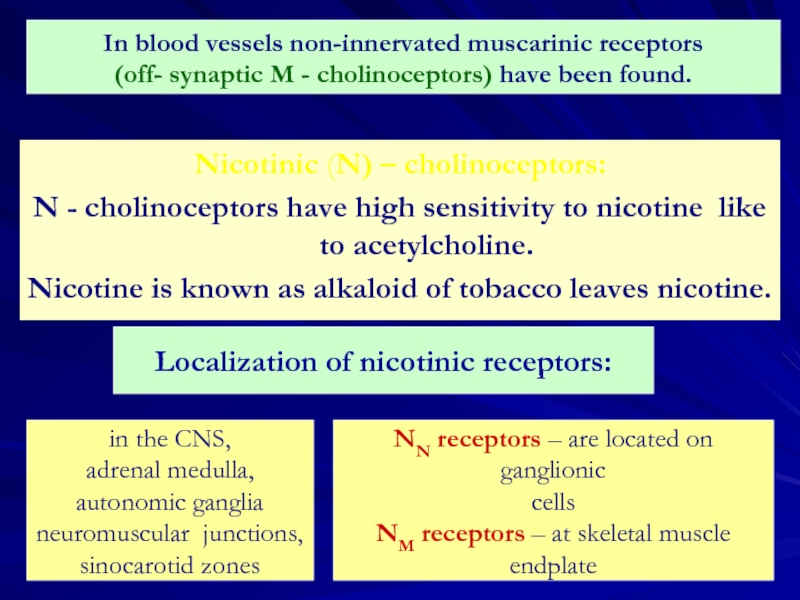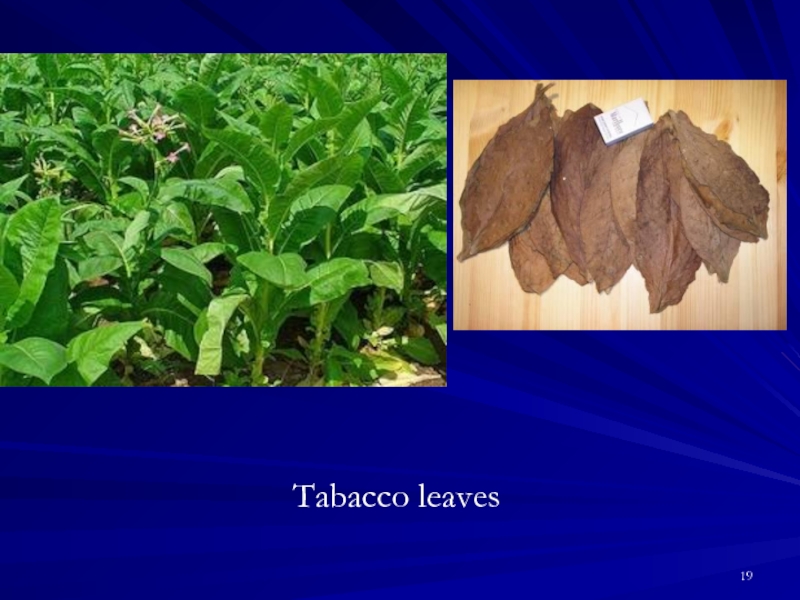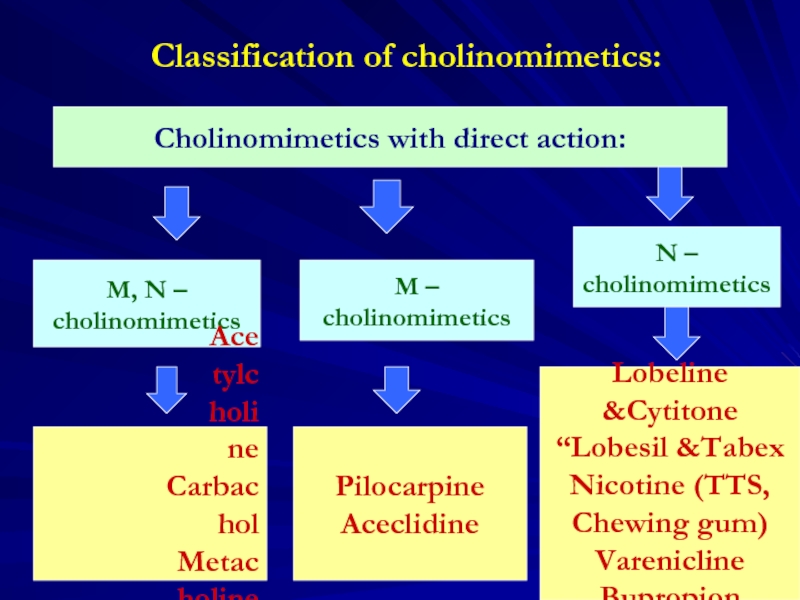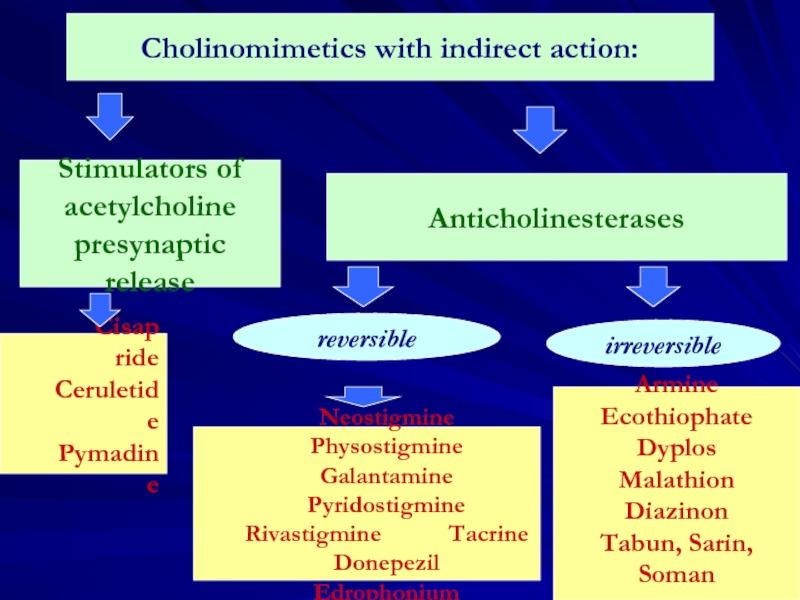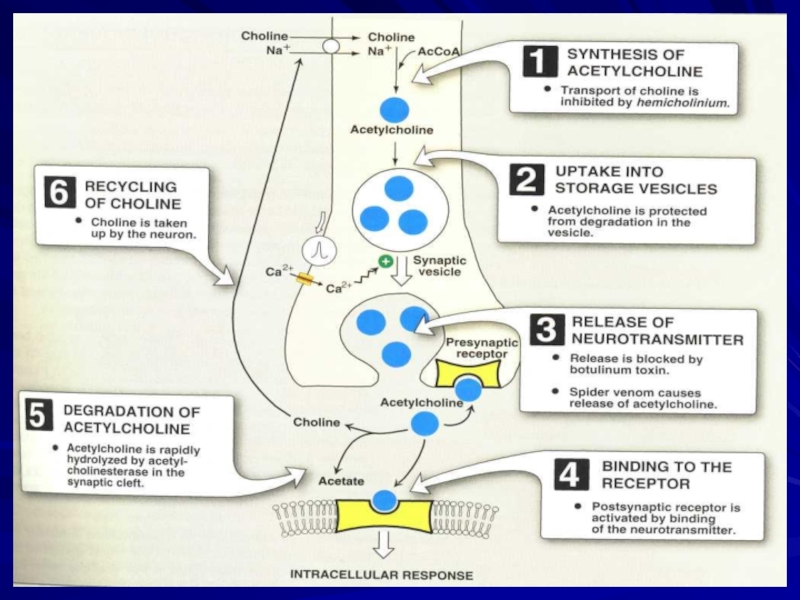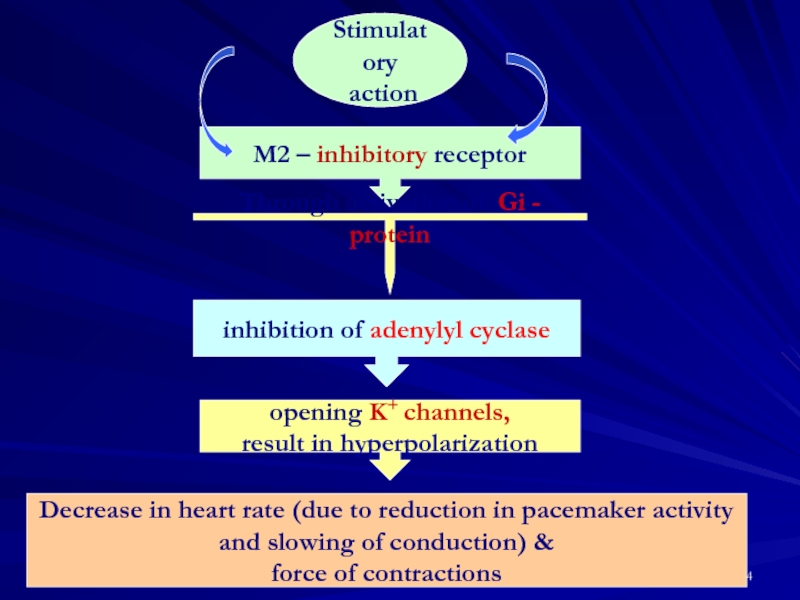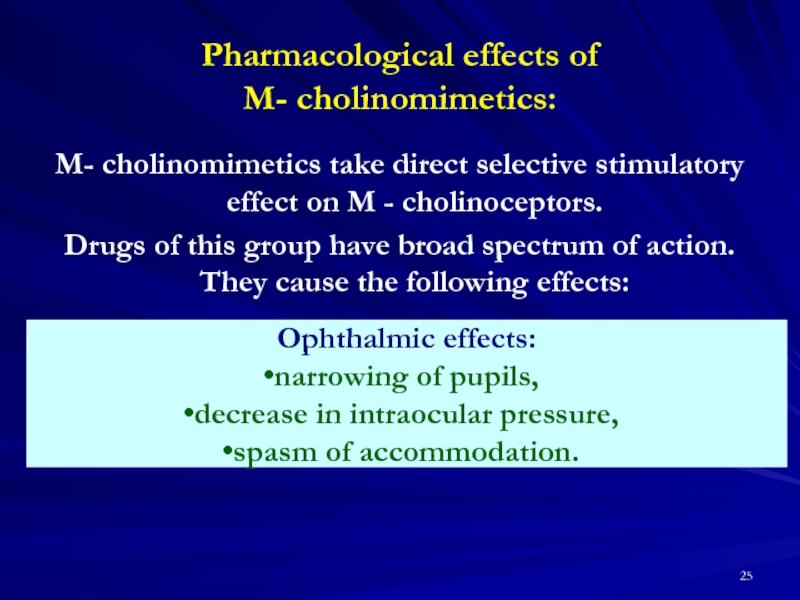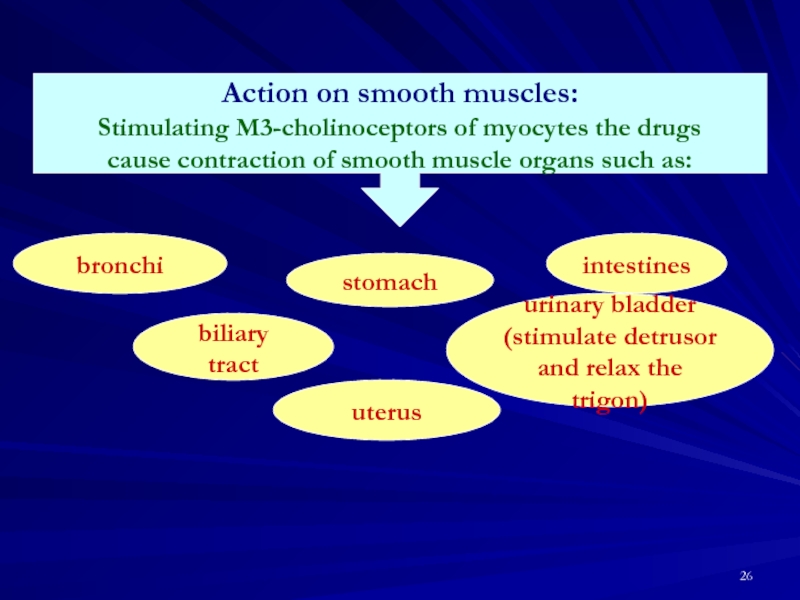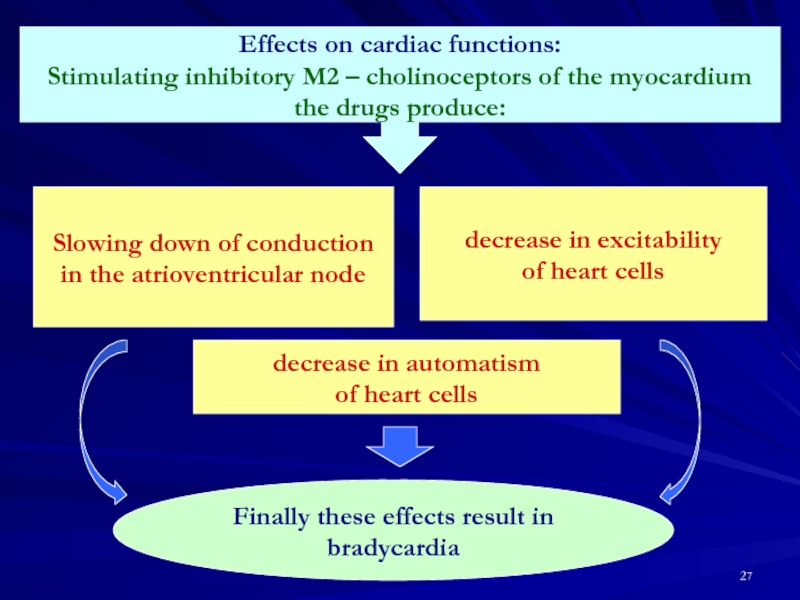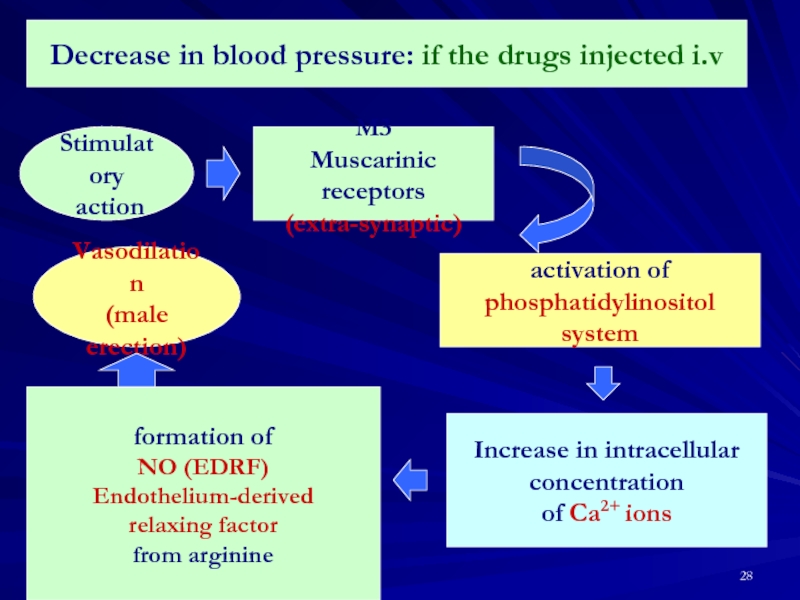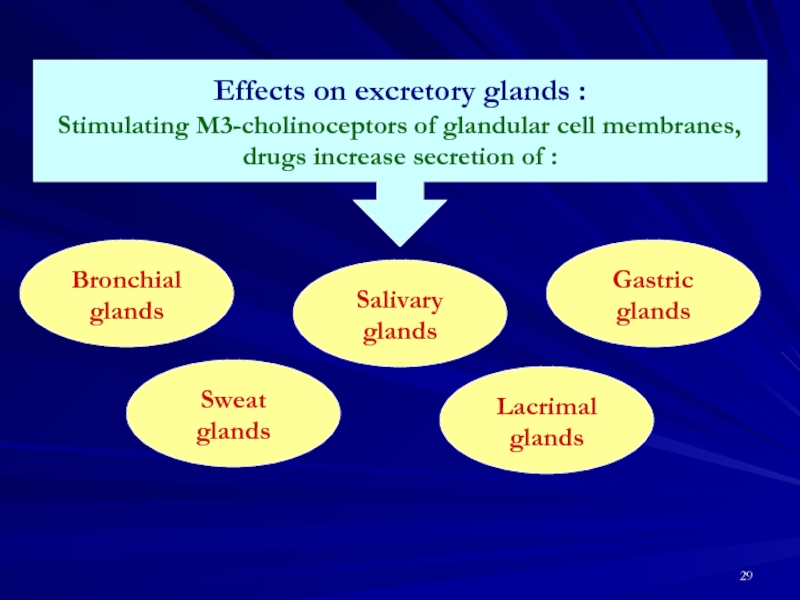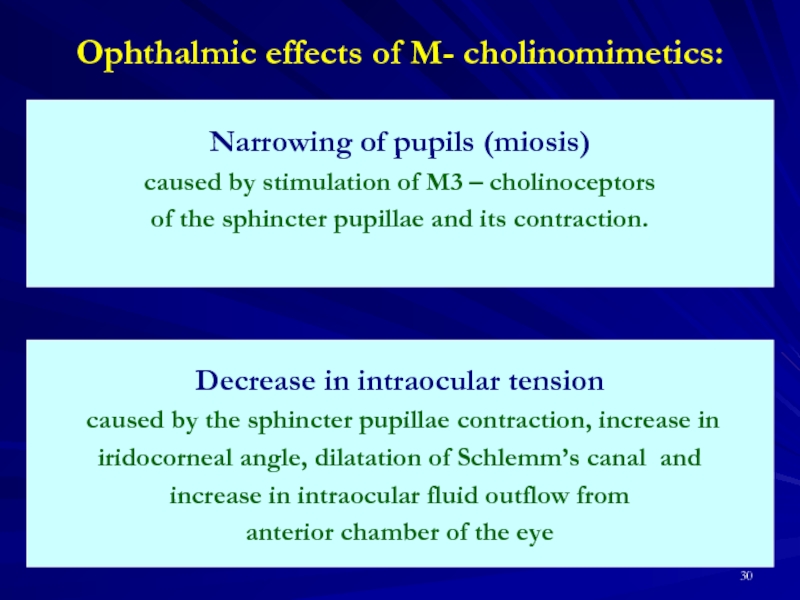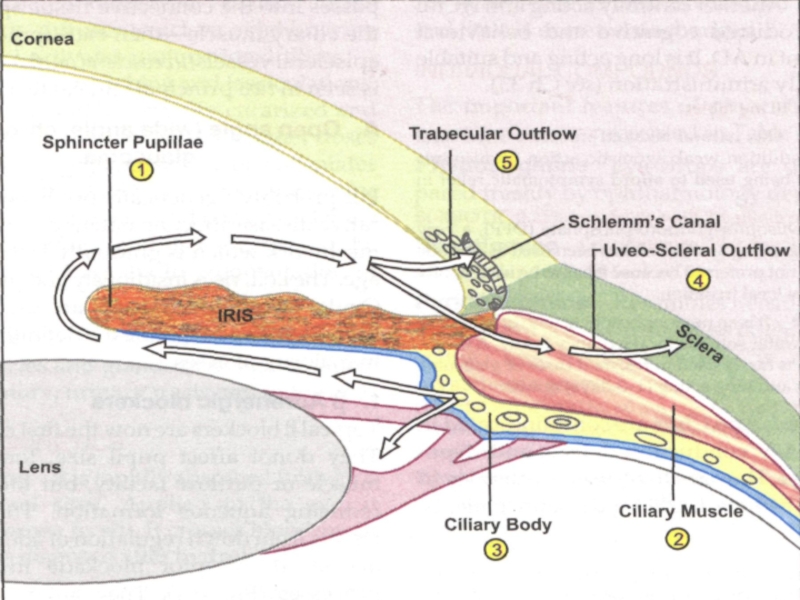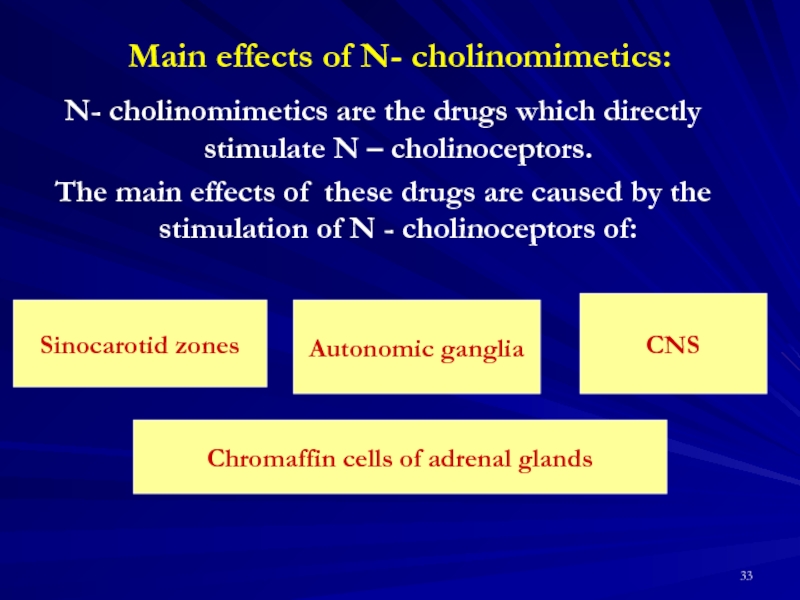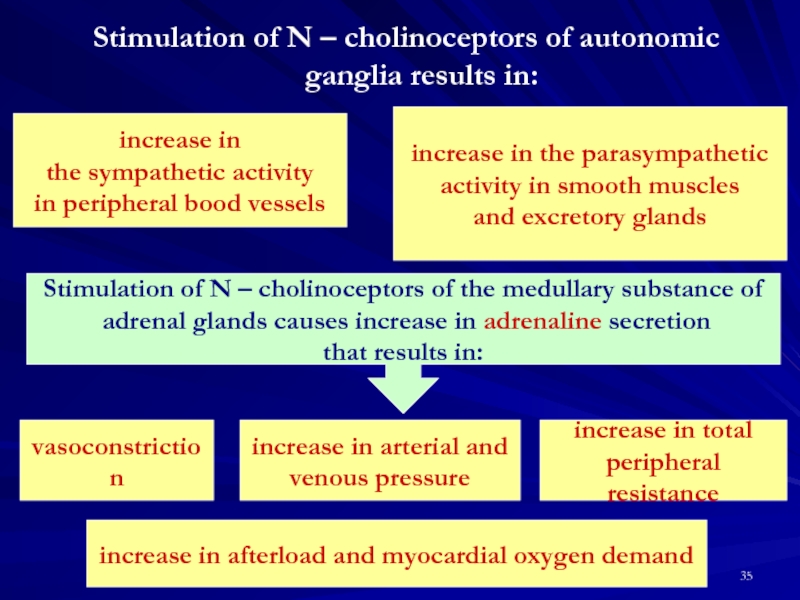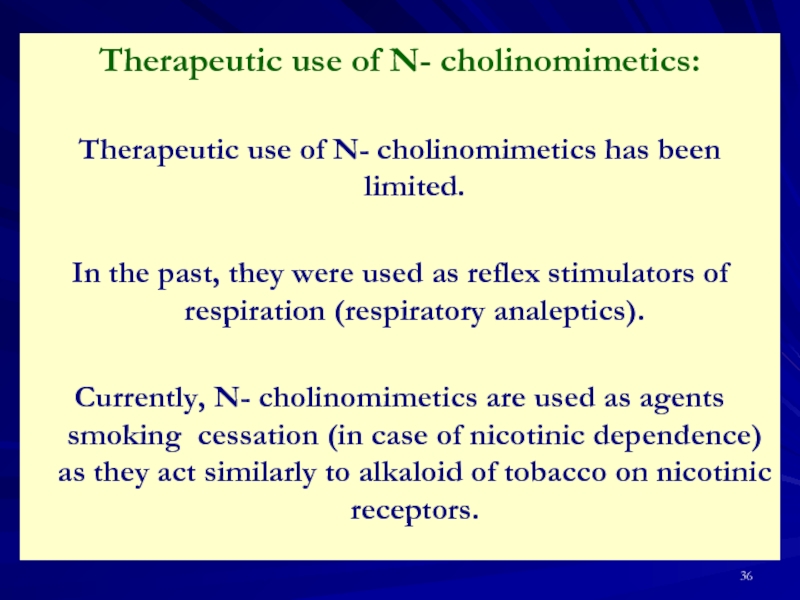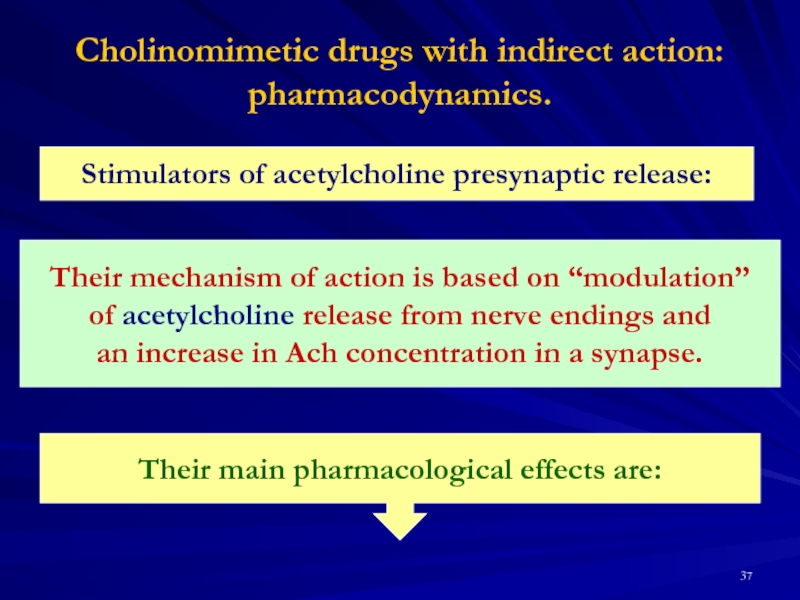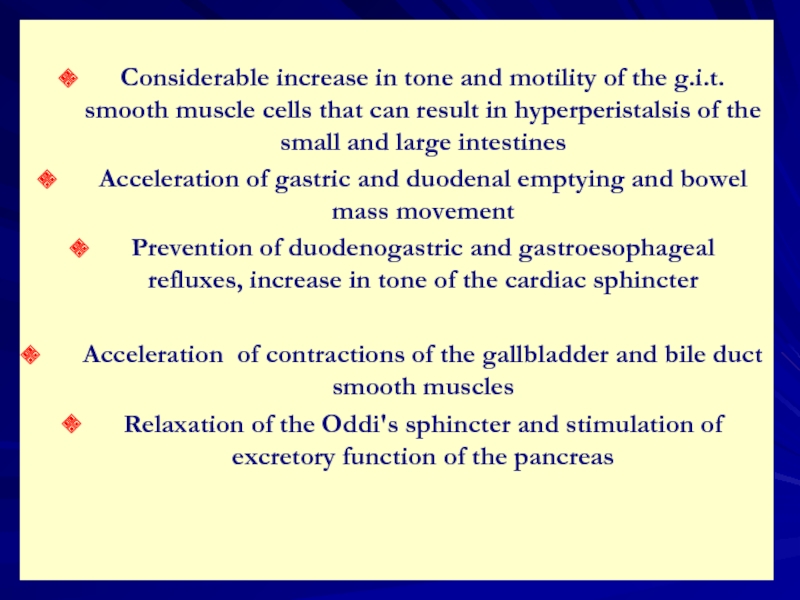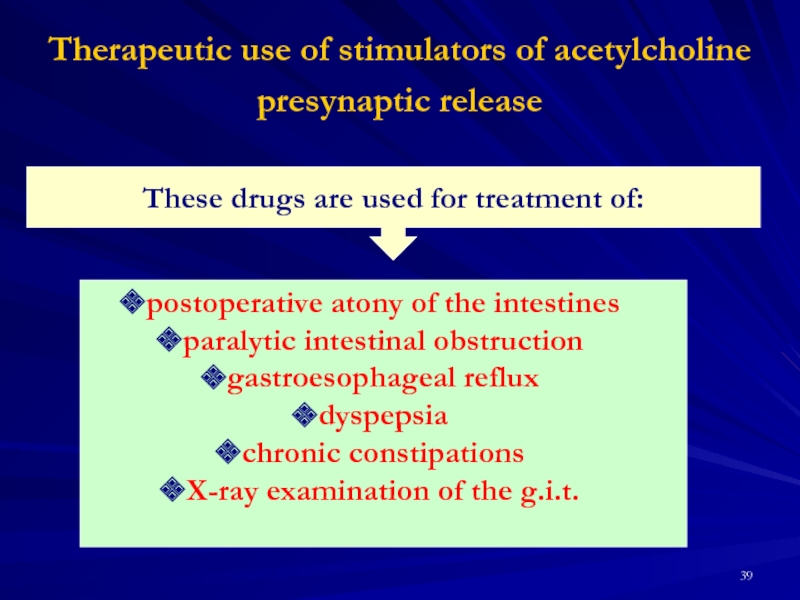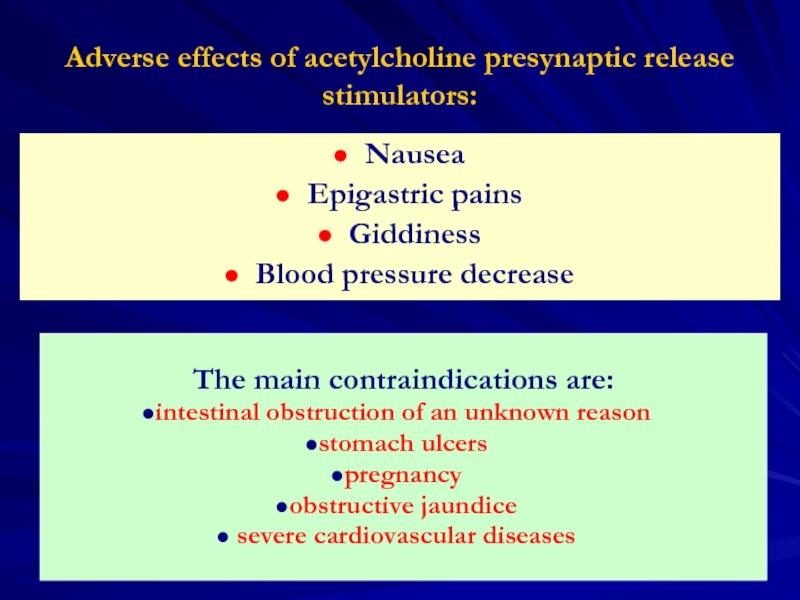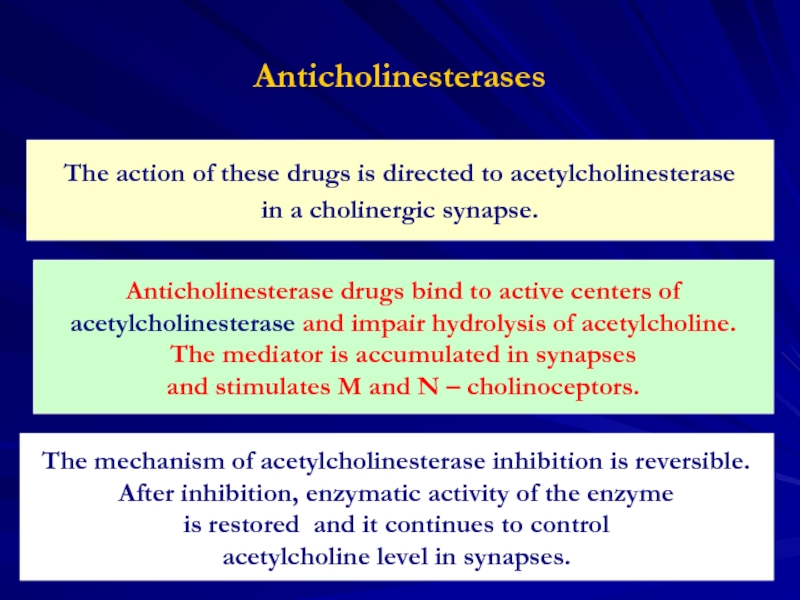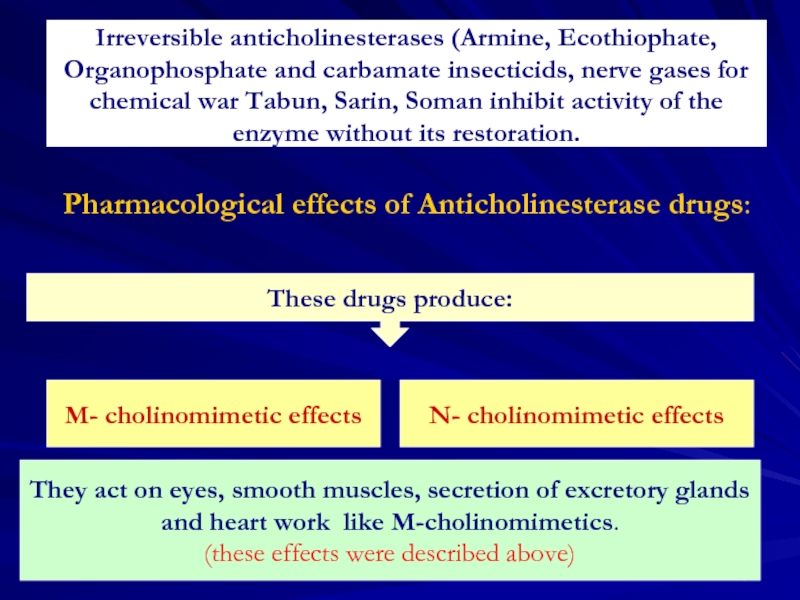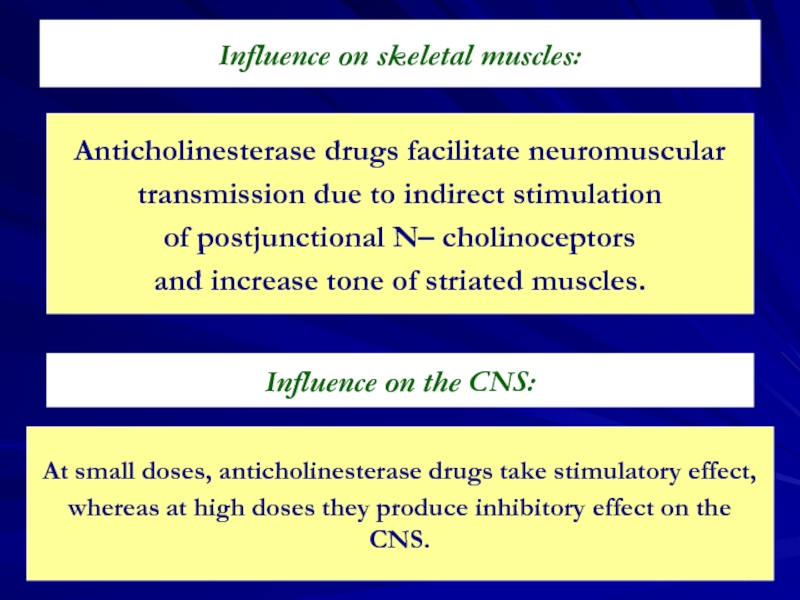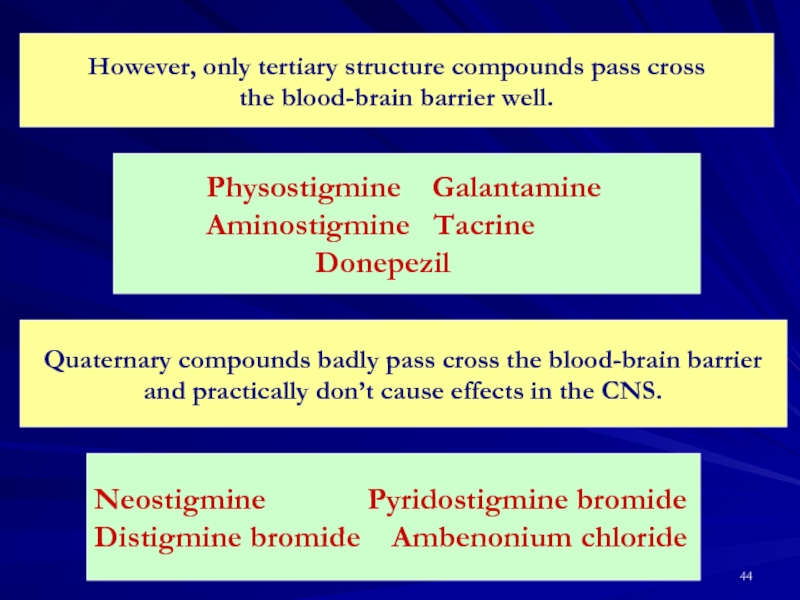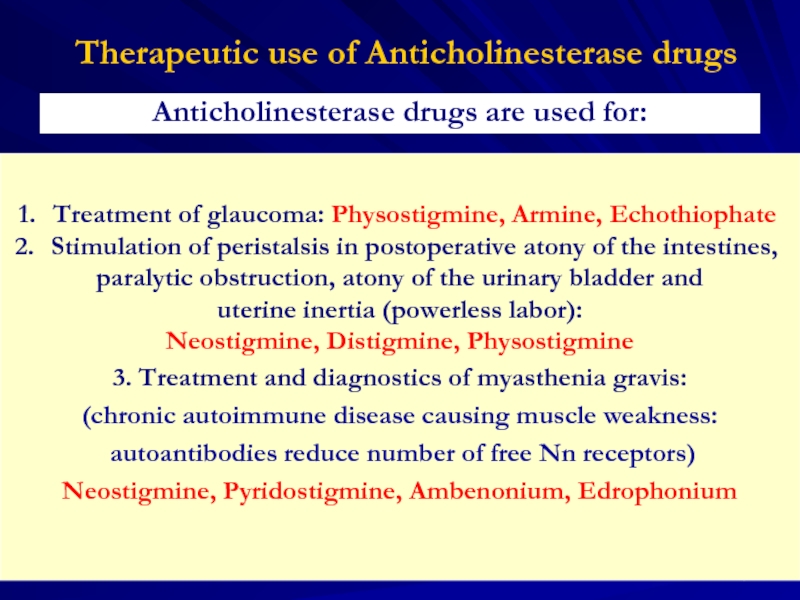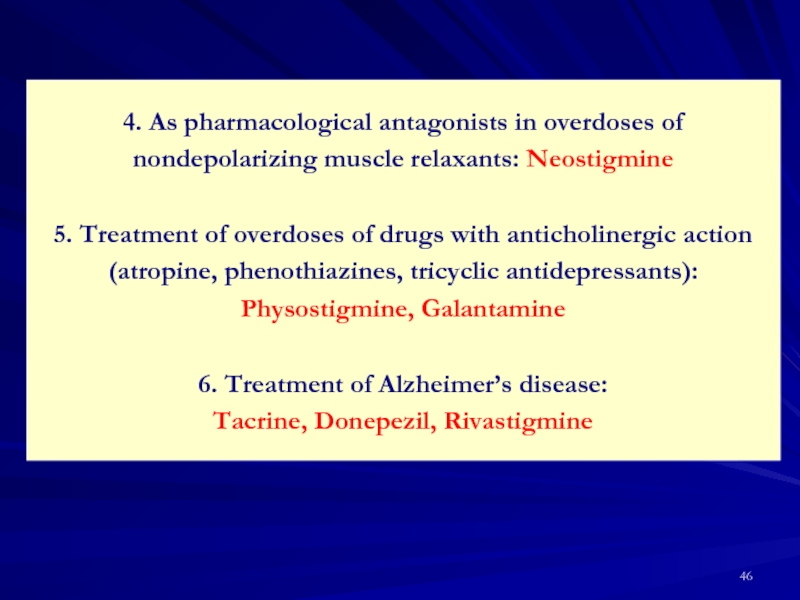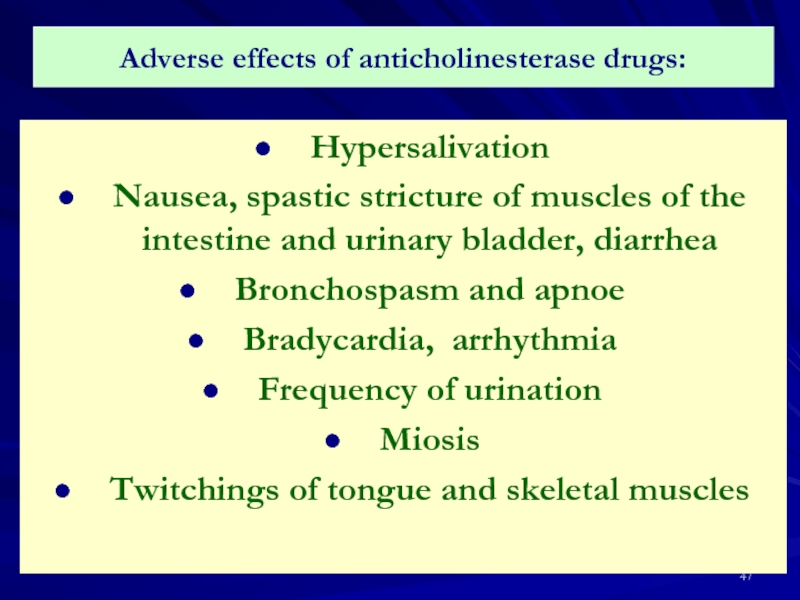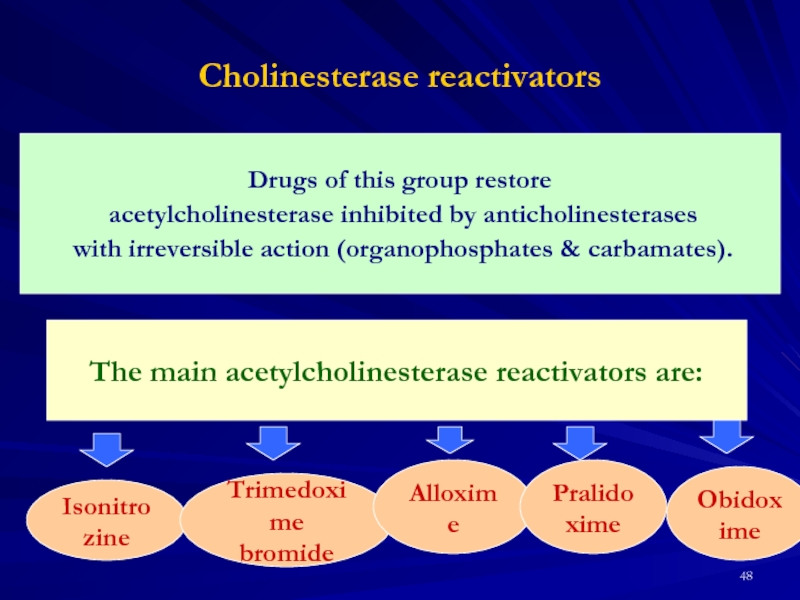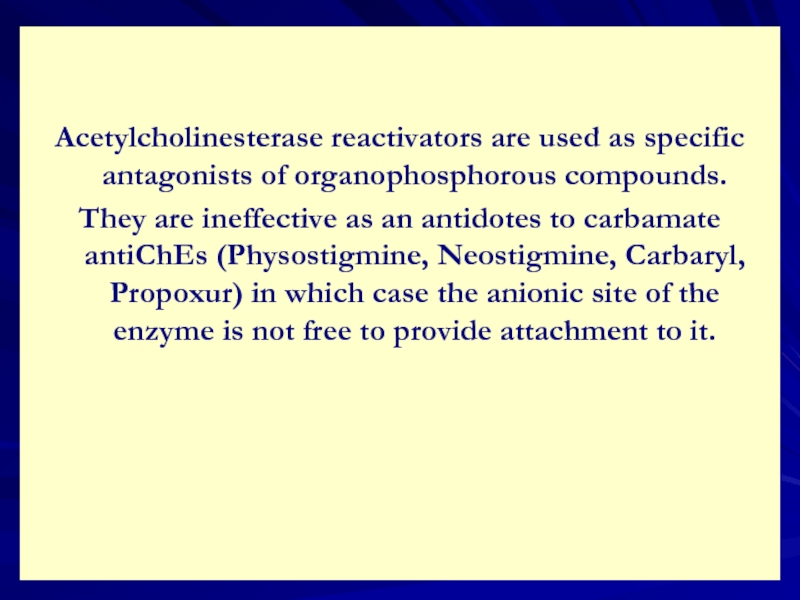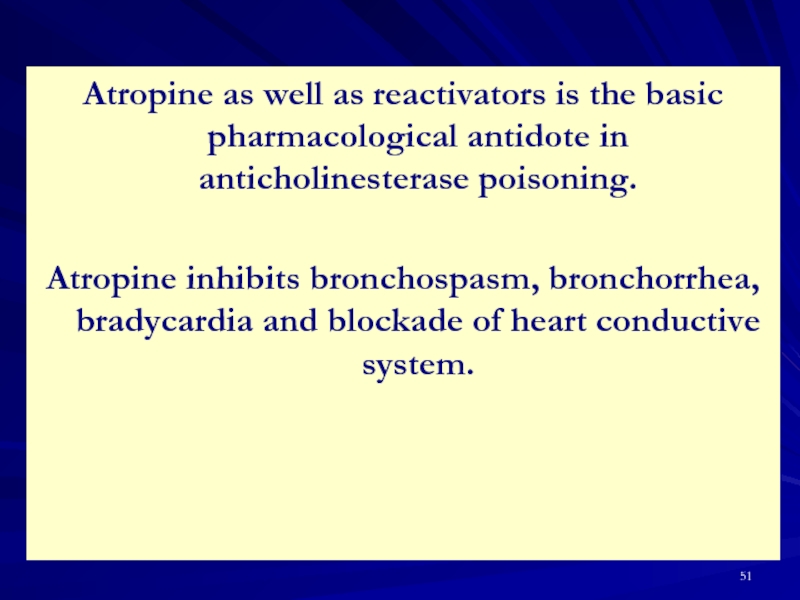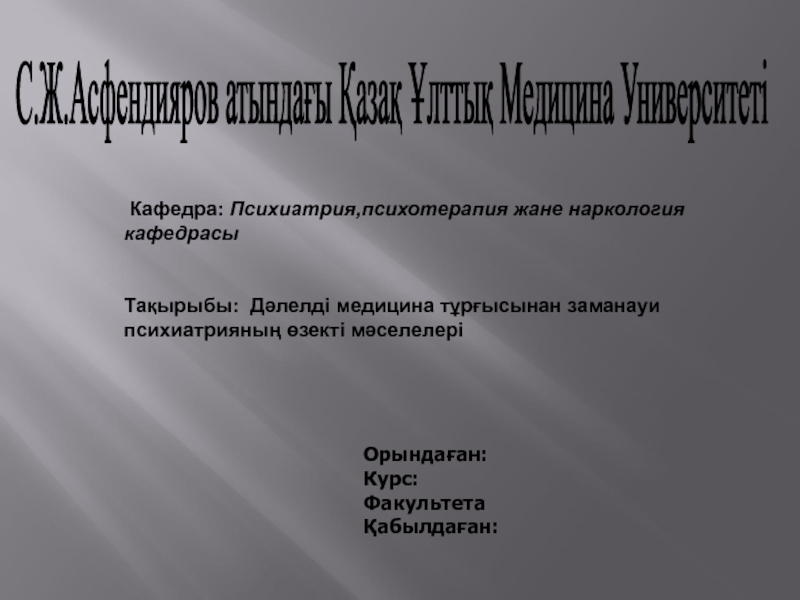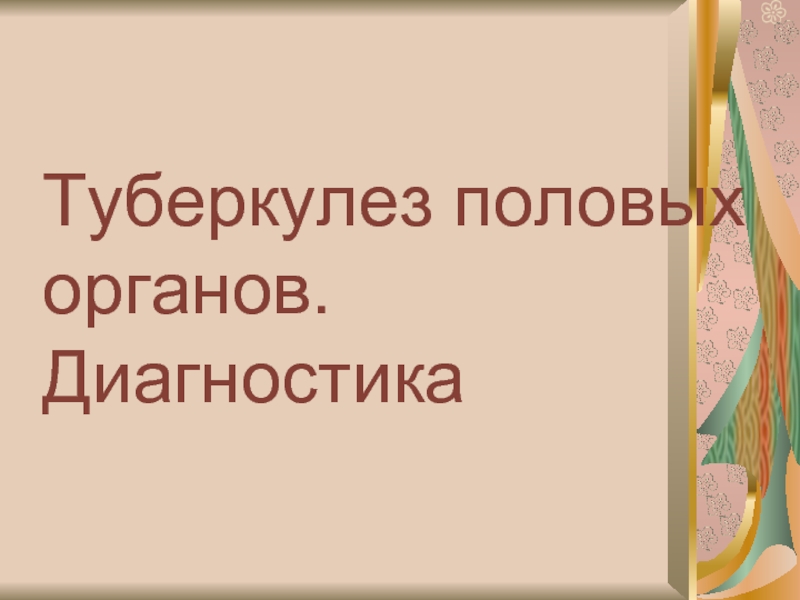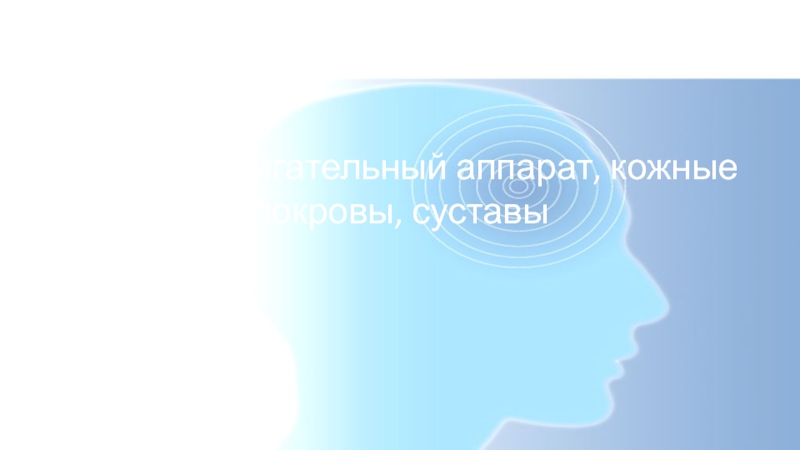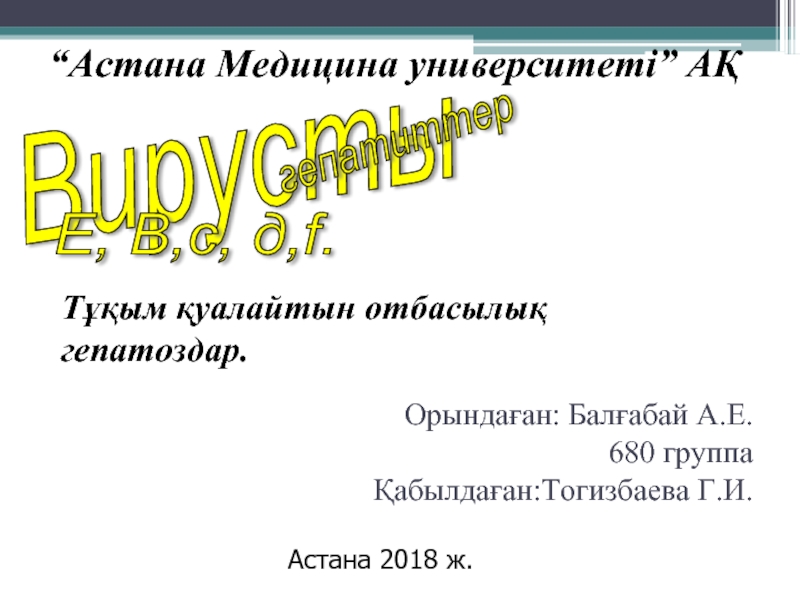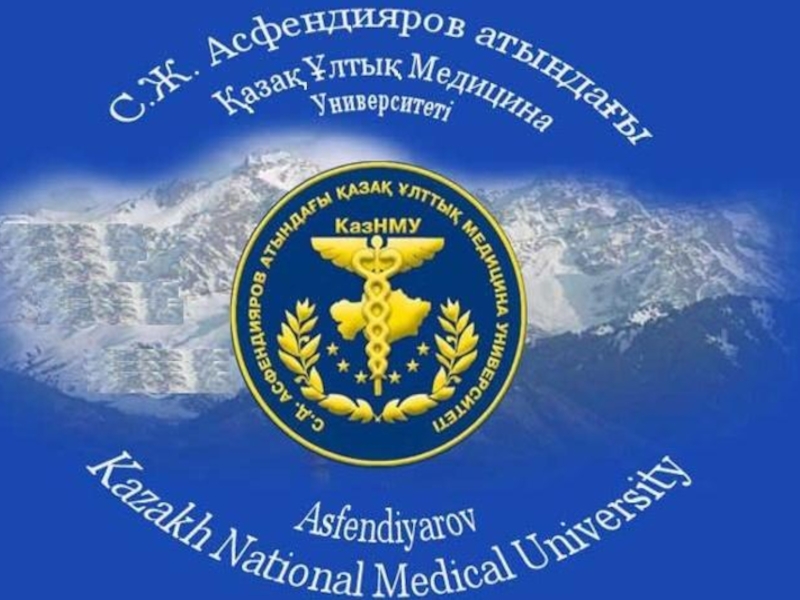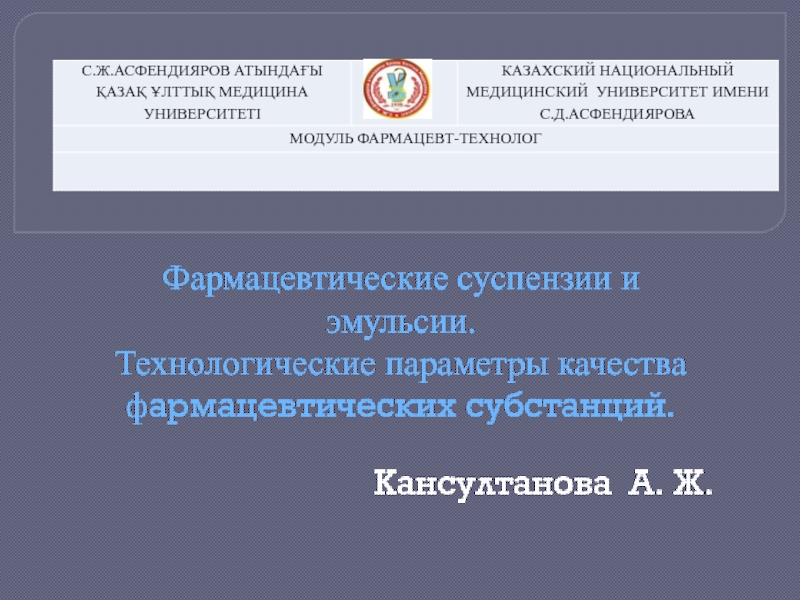- Главная
- Разное
- Дизайн
- Бизнес и предпринимательство
- Аналитика
- Образование
- Развлечения
- Красота и здоровье
- Финансы
- Государство
- Путешествия
- Спорт
- Недвижимость
- Армия
- Графика
- Культурология
- Еда и кулинария
- Лингвистика
- Английский язык
- Астрономия
- Алгебра
- Биология
- География
- Детские презентации
- Информатика
- История
- Литература
- Маркетинг
- Математика
- Медицина
- Менеджмент
- Музыка
- МХК
- Немецкий язык
- ОБЖ
- Обществознание
- Окружающий мир
- Педагогика
- Русский язык
- Технология
- Физика
- Философия
- Химия
- Шаблоны, картинки для презентаций
- Экология
- Экономика
- Юриспруденция
Cholinomimetic and anticholinesterase drugs презентация
Содержание
- 1. Cholinomimetic and anticholinesterase drugs
- 2. Peripheral nervous system Peripheral nervous system
- 3. Peripheral nervous system R E F L
- 4. Classification of drugs acing on PNS Drugs
- 5. Cholinergic synapse The neurotransmission in a cholinergic
- 6. and acetylcholine acts on cholinoceptors located
- 8. Neurotransmitter acetylcholine is synthesized in a
- 9. The transmitter release occurs, when voltage-sensitive
- 10. The released acetylcholine binds to: postsynaptic
- 11. When a nerve impulse is chemically conducted
- 12. Flash movie describing nerve impulse conduction in a synapse
- 15. Cholinergic receptors: Cholinergic receptors are protein macromolecules
- 16. fly agaric
- 17. There are 5 subtypes of muscarinic receptors:
- 18. Nicotinic (N) – cholinoceptors: N - cholinoceptors
- 19. Tabacco leaves
- 20. Classification of cholinomimetics: Cholinomimetics with direct action:
- 21. Cholinomimetics with indirect action: Stimulators
- 23. Molecular mechanism of cholinomimetic action: M1,
- 24. Stimulatory action M2 – inhibitory receptor
- 25. Pharmacological effects of M- cholinomimetics: M-
- 26. Action on smooth muscles: Stimulating M3-cholinoceptors of
- 27. Effects on cardiac functions: Stimulating inhibitory M2
- 28. Decrease in blood pressure: if the drugs
- 29. Effects on excretory glands : Stimulating M3-cholinoceptors
- 30. Ophthalmic effects of M- cholinomimetics: Narrowing of
- 32. Spasm of accommodation due to activation
- 33. Main effects of N- cholinomimetics: N- cholinomimetics
- 34. Effect of N- cholinomimetics is characterized
- 35. Stimulation of N – cholinoceptors of autonomic
- 36. Therapeutic use of N- cholinomimetics: Therapeutic
- 37. Cholinomimetic drugs with indirect action: pharmacodynamics. Stimulators
- 38. Considerable increase in tone and motility
- 39. Therapeutic use of stimulators of acetylcholine presynaptic
- 40. Adverse effects of acetylcholine presynaptic release stimulators:
- 41. Anticholinesterases The action of these drugs is
- 42. Irreversible anticholinesterases (Armine, Ecothiophate, Organophosphate and carbamate
- 43. Influence on skeletal muscles: Anticholinesterase drugs facilitate
- 44. However, only tertiary structure compounds pass cross
- 45. Therapeutic use of Anticholinesterase drugs Anticholinesterase drugs
- 46. 4. As pharmacological antagonists in overdoses of
- 47. Hypersalivation Nausea, spastic stricture of muscles of
- 48. Cholinesterase reactivators Drugs of this group restore
- 49. Reactivators contain oxime group (=N-OH). They attach
- 50. Acetylcholinesterase reactivators are used as
- 51. Atropine as well as reactivators is the
Слайд 1UNIT: CHOLINERGIC DRUGS
THEME: CHOLINOMIMETIC AND ANTICHOLINESTERASE DRUGS
SMOLENSK STATE MEDICAL ACADEMY
PHARMACOLOGY DEPARTMENT
Слайд 2
Peripheral nervous system
Peripheral nervous system consists of afferent (sensory) and efferent
Reflex principle underlies nerve regulation
Слайд 3Peripheral nervous system
R E F L E X is a response
Each reflex is realized
by means of reflex arch
Слайд 4Classification of drugs acing on PNS
Drugs acting on afferent innervation
Drugs inhibiting
Drugs inhibiting afferent nerve fibers
Drugs acting on efferent innervation
Cholinergic agents – acting on cholinergic transmission
Adrenergic agents – acting on adreneric transmission
Слайд 5Cholinergic synapse
The neurotransmission in a cholinergic synapse is realized by the
Preganglionic
nerve fibers
Postganglionic
nerve fibers
Efferent
nerve fibers
Parasympathetic
and sympathetic
nerve systems
Parasympathetic
nerve system
Somatic
nerve system
Слайд 6and acetylcholine acts on cholinoceptors
located on:
Cells of
adrenal medulla
Autonomic
ganglia
Cells
of internals
Striated muscles
Слайд 8Neurotransmitter acetylcholine is synthesized
in a cholinergic nerve ending from:
acetyl-CoA
choline
choline acetyl transferase catalyzes the reaction
The synthesized neurotransmitter is transported into
into vesicles where is packed
(in vesicles acetylcholine is protected from degradation)
Слайд 9The transmitter release occurs, when voltage-sensitive
calcium channels
in the presynaptic
providing influx of calcium ions.
It happens when an action potential arrives
at a nerve ending
Increase in endocellular concentration of calcium occurs
and in turn, it causes the fusion of vesicles with
membrane surface and release of their content
(Ach, co-transmitters- ATP) into the synaptic cleft
by exocytosis.
Слайд 10The released acetylcholine binds to:
postsynaptic receptors
presynaptic receptors
muscarinic
nicotinic
Binding of acetylcholine to
postsynaptic receptors results in
a biological response within cells
of target organs (the myocardium,
g.i.t., excretory glands, eyes, etc)
Binding of acetylcholine to
presynaptic receptors
results in discontinuation
of its release
(negative feedback
mechanism)
Слайд 11When a nerve impulse is chemically conducted
(by acetylcholine action), the
terminates the Ach action by its hydrolysis
with formation of:
choline
acetate
Choline formed is actively uptaken by the
axonal membrane (by a Na+:choline
cotransporter)
and is used for
acetylcholine resynthesis again.
Is removed
Слайд 15Cholinergic receptors:
Cholinergic receptors are protein macromolecules having specific sensitivity to acetylcholine.
They are not homogeneous.
Two basic groups of cholinoceptors such as M- cholinoceptors and N- cholinoceptors have been identified with the help of natural alkaloids.
Receptors which have high sensitivity to muscarine (alkaloid of the mushroom fly-agaric) are called
M - cholinoceptors (muscarinic receptors).
Слайд 17There are 5 subtypes of muscarinic receptors:
M1, M3 and M5 subtypes
M2, M4 subtypes inhibit cellular excitation (inhibitory receptors)
Localization of muscarinic receptors:
M1
M2
M3
On ganglion cells and
central neurones,
escpecially in cortex,
hyppocampus and
corpus striatum.
It plays a major role in
mediating gastric
secretion, relaxation of
LES, in learning, memo-
ry, motor functions
on effector cells
of myocardium
and presynaptic
membrane
(cholinergic nerve
ending)
on smooth muscles
of g.i.t., bronchi,
urogenital system,
on eye muscles,
on excretory glands
Слайд 18Nicotinic (N) – cholinoceptors:
N - cholinoceptors have high sensitivity to nicotine
Nicotine is known as alkaloid of tobacco leaves nicotine.
Localization of nicotinic receptors:
in the CNS,
adrenal medulla,
autonomic ganglia
neuromuscular junctions,
sinocarotid zones
In blood vessels non-innervated muscarinic receptors
(off- synaptic M - cholinoceptors) have been found.
NN receptors – are located on ganglionic
cells
NM receptors – at skeletal muscle
endplate
Слайд 20Classification of cholinomimetics:
Cholinomimetics with direct action:
M, N –
cholinomimetics
M –
cholinomimetics
Acetylcholine
Carbachol
Metacholine
Bethanecol
Pilocarpine
Aceclidine
N –
cholinomimetics
Lobeline &Cytitone
“Lobesil &Tabex
Nicotine (TTS,
Chewing gum)
Varenicline
Bupropion
Слайд 21Cholinomimetics with indirect action:
Stimulators of
acetylcholine
presynaptic release
Anticholinesterases
Cisapride
Ceruletide
Pymadine
Neostigmine Physostigmine
Galantamine
Rivastigmine Tacrine
Donepezil Edrophonium
reversible
irreversible
Armine
Ecothiophate
Dyplos
Malathion
Diazinon
Tabun, Sarin, Soman
Слайд 23Molecular mechanism of cholinomimetic action:
M1, M3 -receptors
(activating)
Stimulatory
action
Through Gq protein
activate
phospholipase
hydrolyses
phosphatidylinositol -4,5-
bisphosphate (PIP2)
formation of
Diacylglycerol (DAG)
Inositol (1,4,5)-triphosphate (IP3)
depolarization
Secretion
Contraction
Stimulation or inhibition
of enzymes
influx of
Ca2+ ions,
production of
protein kinase C
Слайд 24Stimulatory
action
M2 – inhibitory receptor
Through activation of Gi - protein
inhibition of
opening K+ channels,
result in hyperpolarization
Decrease in heart rate (due to reduction in pacemaker activity
and slowing of conduction) &
force of contractions
Слайд 25Pharmacological effects of
M- cholinomimetics:
M- cholinomimetics take direct selective stimulatory effect
Drugs of this group have broad spectrum of action. They cause the following effects:
Ophthalmic effects:
narrowing of pupils,
decrease in intraocular pressure,
spasm of accommodation.
Слайд 26Action on smooth muscles:
Stimulating M3-cholinoceptors of myocytes the drugs
cause contraction of
bronchi
stomach
intestines
biliary tract
urinary bladder
(stimulate detrusor
and relax the trigon)
uterus
Слайд 27Effects on cardiac functions:
Stimulating inhibitory M2 – cholinoceptors of the myocardium
the
Slowing down of conduction
in the atrioventricular node
decrease in excitability
of heart cells
decrease in automatism
of heart cells
Finally these effects result in bradycardia
Слайд 28Decrease in blood pressure: if the drugs injected i.v
Stimulatory
action
M3
Muscarinic receptors
(extra-synaptic)
activation
phosphatidylinositol
system
Increase in intracellular
concentration
of Ca2+ ions
formation of
NO (EDRF)
Endothelium-derived
relaxing factor
from arginine
Vasodilation
(male erection)
Слайд 29Effects on excretory glands :
Stimulating M3-cholinoceptors of glandular cell membranes,
drugs increase
Bronchial
glands
Salivary
glands
Gastric
glands
Sweat
glands
Lacrimal
glands
Слайд 30Ophthalmic effects of M- cholinomimetics:
Narrowing of pupils (miosis)
caused by stimulation of
of the sphincter pupillae and its contraction.
Decrease in intraocular tension
caused by the sphincter pupillae contraction, increase in
iridocorneal angle, dilatation of Sсhlemm’s canal and
increase in intraocular fluid outflow from
anterior chamber of the eye
Слайд 32Spasm of accommodation
due to activation of M3 – cholinoceptors of
Contraction of the eyeball muscle decreases the diameter
of the muscle.
Ligament of Zinn between the muscle and the lens relaxes.
The lens becomes more convex,
An eye becomes focused on the nearest point of vision.
At the same time ciliary muscle contraction increases further
opening of Schlemm’s canal
that improves fluid outflow into venous network
and helps to decrease in intraocular pressure
Слайд 33Main effects of N- cholinomimetics:
N- cholinomimetics are the drugs which directly
The main effects of these drugs are caused by the stimulation of N - cholinoceptors of:
Sinocarotid zones
Autonomic ganglia
CNS
Chromaffin cells of adrenal glands
Слайд 34
Effect of N- cholinomimetics is characterized by the action consisting of
Stimulation of N – cholinoceptors of carotid bodies results in reflex stimulation of neurons of the medulla oblongata, first of all, neurons of the respiratory center.
However, after the stimulation N- cholinomimetics can cause inhibition of these neurons and even apnoea (respiratory standstill).
Слайд 35Stimulation of N – cholinoceptors of autonomic ganglia results in:
increase in
the sympathetic activity
in peripheral bood vessels
increase in the parasympathetic
activity in smooth muscles
and excretory glands
Stimulation of N – cholinoceptors of the medullary substance of
adrenal glands causes increase in adrenaline secretion
that results in:
vasoconstriction
increase in arterial and
venous pressure
increase in total
peripheral resistance
increase in afterload and myocardial oxygen demand
Слайд 36Therapeutic use of N- cholinomimetics:
Therapeutic use of N- cholinomimetics has been
In the past, they were used as reflex stimulators of respiration (respiratory analeptics).
Currently, N- cholinomimetics are used as agents smoking cessation (in case of nicotinic dependence) as they act similarly to alkaloid of tobacco on nicotinic receptors.
Слайд 37Cholinomimetic drugs with indirect action:
pharmacodynamics.
Stimulators of acetylcholine presynaptic release:
Their mechanism
of acetylcholine release from nerve endings and
an increase in Ach concentration in a synapse.
Their main pharmacological effects are:
Слайд 38
Considerable increase in tone and motility of the g.i.t. smooth muscle
Acceleration of gastric and duodenal emptying and bowel mass movement
Prevention of duodenogastric and gastroesophageal refluxes, increase in tone of the cardiac sphincter
Acceleration of contractions of the gallbladder and bile duct smooth muscles
Relaxation of the Oddi's sphincter and stimulation of excretory function of the pancreas
Слайд 39Therapeutic use of stimulators of acetylcholine presynaptic release
These drugs are
postoperative atony of the intestines
paralytic intestinal obstruction
gastroesophageal reflux
dyspepsia
chronic constipations
X-ray examination of the g.i.t.
Слайд 40Adverse effects of acetylcholine presynaptic release stimulators:
Nausea
Epigastric pains
Giddiness
Blood
The main contraindications are:
intestinal obstruction of an unknown reason
stomach ulcers
pregnancy
obstructive jaundice
severe cardiovascular diseases
Слайд 41Anticholinesterases
The action of these drugs is directed to acetylcholinesterase
in a
Anticholinesterase drugs bind to active centers of
acetylcholinesterase and impair hydrolysis of acetylcholine.
The mediator is accumulated in synapses
and stimulates M and N – cholinoceptors.
The mechanism of acetylcholinesterase inhibition is reversible.
After inhibition, enzymatic activity of the enzyme
is restored and it continues to control
acetylcholine level in synapses.
Слайд 42Irreversible anticholinesterases (Armine, Ecothiophate, Organophosphate and carbamate insecticids, nerve gases for
Pharmacological effects of Anticholinesterase drugs:
These drugs produce:
М- cholinomimetic effects
N- cholinomimetic effects
They act on eyes, smooth muscles, secretion of excretory glands
and heart work like M-cholinomimetics.
(these effects were described above)
Слайд 43Influence on skeletal muscles:
Anticholinesterase drugs facilitate neuromuscular
transmission due to indirect
of postjunctional N– cholinoceptors
and increase tone of striated muscles.
Influence on the CNS:
At small doses, anticholinesterase drugs take stimulatory effect,
whereas at high doses they produce inhibitory effect on the CNS.
Слайд 44However, only tertiary structure compounds pass cross
the blood-brain barrier well.
Physostigmine Galantamine
Aminostigmine Tacrine
Donepezil
Quaternary compounds badly pass cross the blood-brain barrier
and practically don’t cause effects in the CNS.
Neostigmine Pyridostigmine bromide
Distigmine bromide Ambenonium chloride
Слайд 45Therapeutic use of Anticholinesterase drugs
Anticholinesterase drugs are used for:
Treatment of glaucoma:
Stimulation of peristalsis in postoperative atony of the intestines,
paralytic obstruction, atony of the urinary bladder and
uterine inertia (powerless labor):
Neostigmine, Distigmine, Physostigmine
3. Treatment and diagnostics of myasthenia gravis:
(chronic autoimmune disease causing muscle weakness:
autoantibodies reduce number of free Nn receptors)
Neostigmine, Pyridostigmine, Ambenonium, Edrophonium
Слайд 464. As pharmacological antagonists in overdoses of
nondepolarizing muscle relaxants: Neostigmine
5.
(atropine, phenothiazines, tricyclic antidepressants):
Physostigmine, Galantamine
6. Treatment of Alzheimer’s disease:
Tacrine, Donepezil, Rivastigmine
Слайд 47Hypersalivation
Nausea, spastic stricture of muscles of the intestine and urinary bladder,
Bronchospasm and apnoe
Bradycardia, arrhythmia
Frequency of urination
Miosis
Twitchings of tongue and skeletal muscles
Adverse effects of anticholinesterase drugs:
Слайд 48Cholinesterase reactivators
Drugs of this group restore
acetylcholinesterase inhibited by anticholinesterases
with
The main acetylcholinesterase reactivators are:
Isonitrozine
Trimedoxime
bromide
Alloxime
Pralidoxime
Obidoxime
Слайд 49Reactivators contain oxime group (=N-OH). They attach to the anionic site
Its oxime end reacts with the phosphorous atom attached to the esteratic site: the oxime:phosphonate diffuses away leaving the reactivated ChE.
Mechanism of acetylcholinesterase reactivator action:
Слайд 50
Acetylcholinesterase reactivators are used as specific antagonists of organophosphorous compounds.
They are
Слайд 51Atropine as well as reactivators is the basic pharmacological antidote in
Atropine inhibits bronchospasm, bronchorrhea, bradycardia and blockade of heart conductive system.
